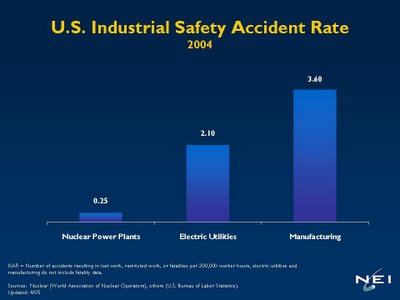The World Association of Nuclear Operators (WANO)'s mission is

The ISAR is calculated by taking the number of accidents resulting in lost work, restricted work, or fatalities for every 200,000 worker hours. The Bureau of Labor Statistics refers to this as 100 full-time workers (100 workers * 40 hours per week * 50 weeks = 200,000 worker hours). Please note that the rate reported from BLS does not include fatalities.
To find what these rates are for other industries in the U.S. go to the BLS IIF webpage. If you scroll down to Get Detailed IIF Statistics under Create Customized Tables (one screen), you can click on Occupational injuries and illnesses (2003 forward). From here you can query any industry in the U.S. You won'’t be able to find nuclear power plants but you will be able to find Electric Power Generation, Transmission and Distribution as well as the Manufacturing industry. For kicks, check out what some of the rates are for Financial Activities -- you'll be surprised at what you find.
On WANO's website, world performance indicators are available. The ISAR for the world is lower (.21) than the U.S. (.25) for 2004. However, only half of the plants outside the U.S. report that data. The WANO data I refer to here is for members only, so here'’s NEI'’s link to the data back to 1980.
Technorati tags: Nuclear Energy, Nuclear Power, Electricity, Energy, Industrial Safety
To maximise the safety and reliability of the operation of nuclear power plants by exchanging information and encouraging communication, comparison and emulation amongst its members.WANO provides a wide variety of data on the nuclear industry, and today, we're going to look at the Industrial Safety Accident Rate or ISAR. According to WANO, the ISAR at U.S. nuclear power plants is far lower than the rate at related industries like electric utilities or manufacturing.

The ISAR is calculated by taking the number of accidents resulting in lost work, restricted work, or fatalities for every 200,000 worker hours. The Bureau of Labor Statistics refers to this as 100 full-time workers (100 workers * 40 hours per week * 50 weeks = 200,000 worker hours). Please note that the rate reported from BLS does not include fatalities.
To find what these rates are for other industries in the U.S. go to the BLS IIF webpage. If you scroll down to Get Detailed IIF Statistics under Create Customized Tables (one screen), you can click on Occupational injuries and illnesses (2003 forward). From here you can query any industry in the U.S. You won'’t be able to find nuclear power plants but you will be able to find Electric Power Generation, Transmission and Distribution as well as the Manufacturing industry. For kicks, check out what some of the rates are for Financial Activities -- you'll be surprised at what you find.
On WANO's website, world performance indicators are available. The ISAR for the world is lower (.21) than the U.S. (.25) for 2004. However, only half of the plants outside the U.S. report that data. The WANO data I refer to here is for members only, so here'’s NEI'’s link to the data back to 1980.
Technorati tags: Nuclear Energy, Nuclear Power, Electricity, Energy, Industrial Safety
Comments